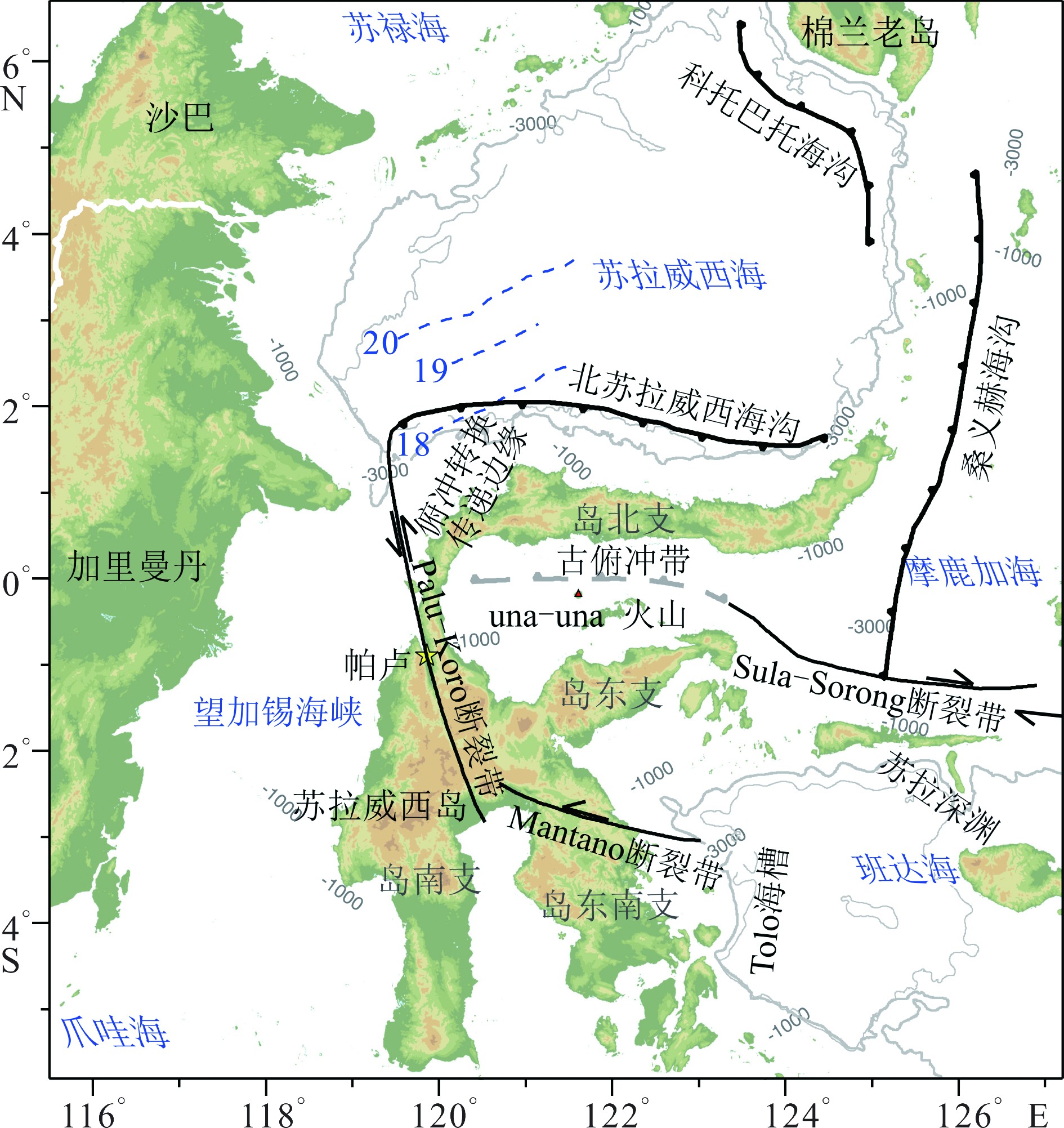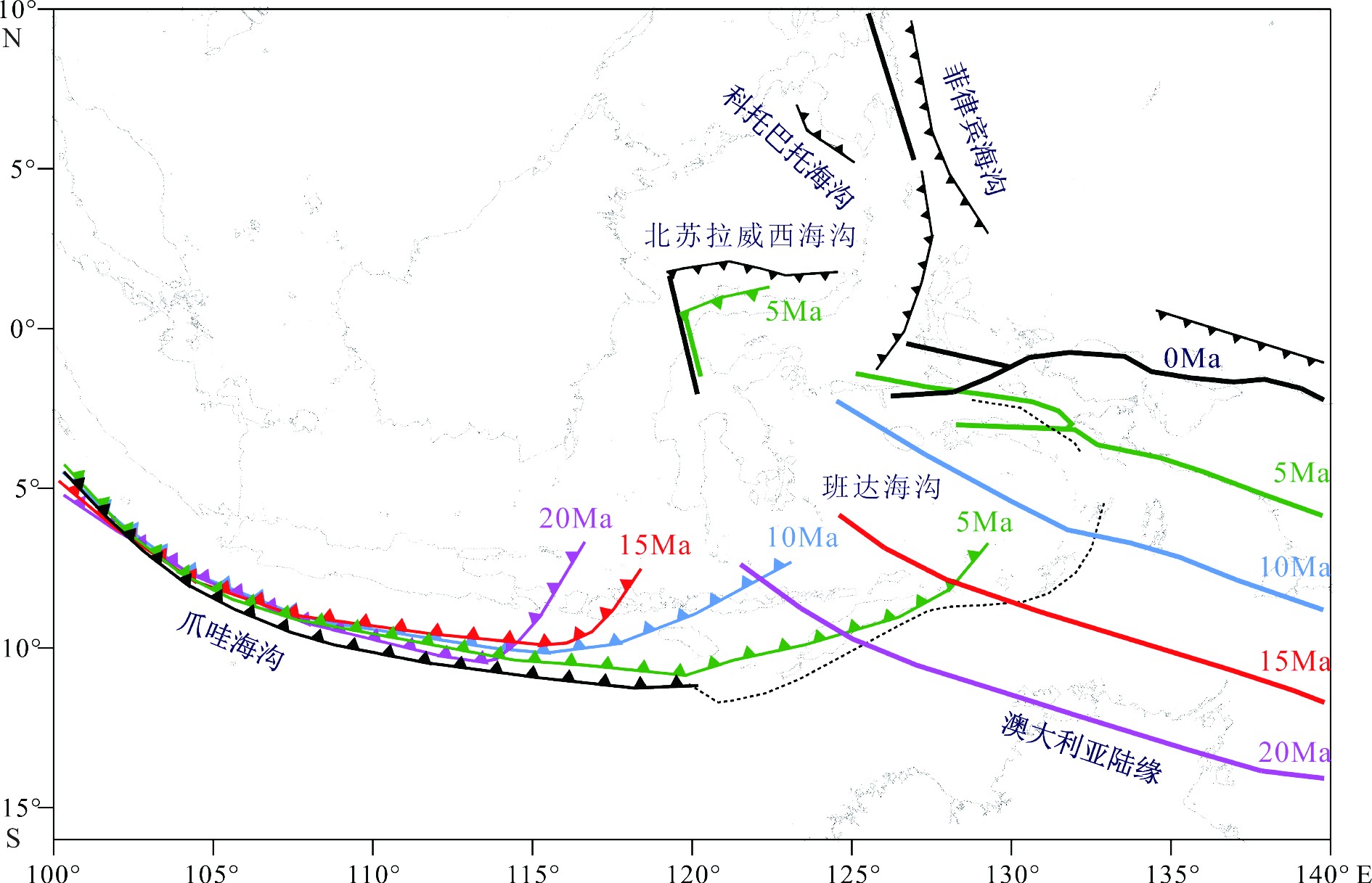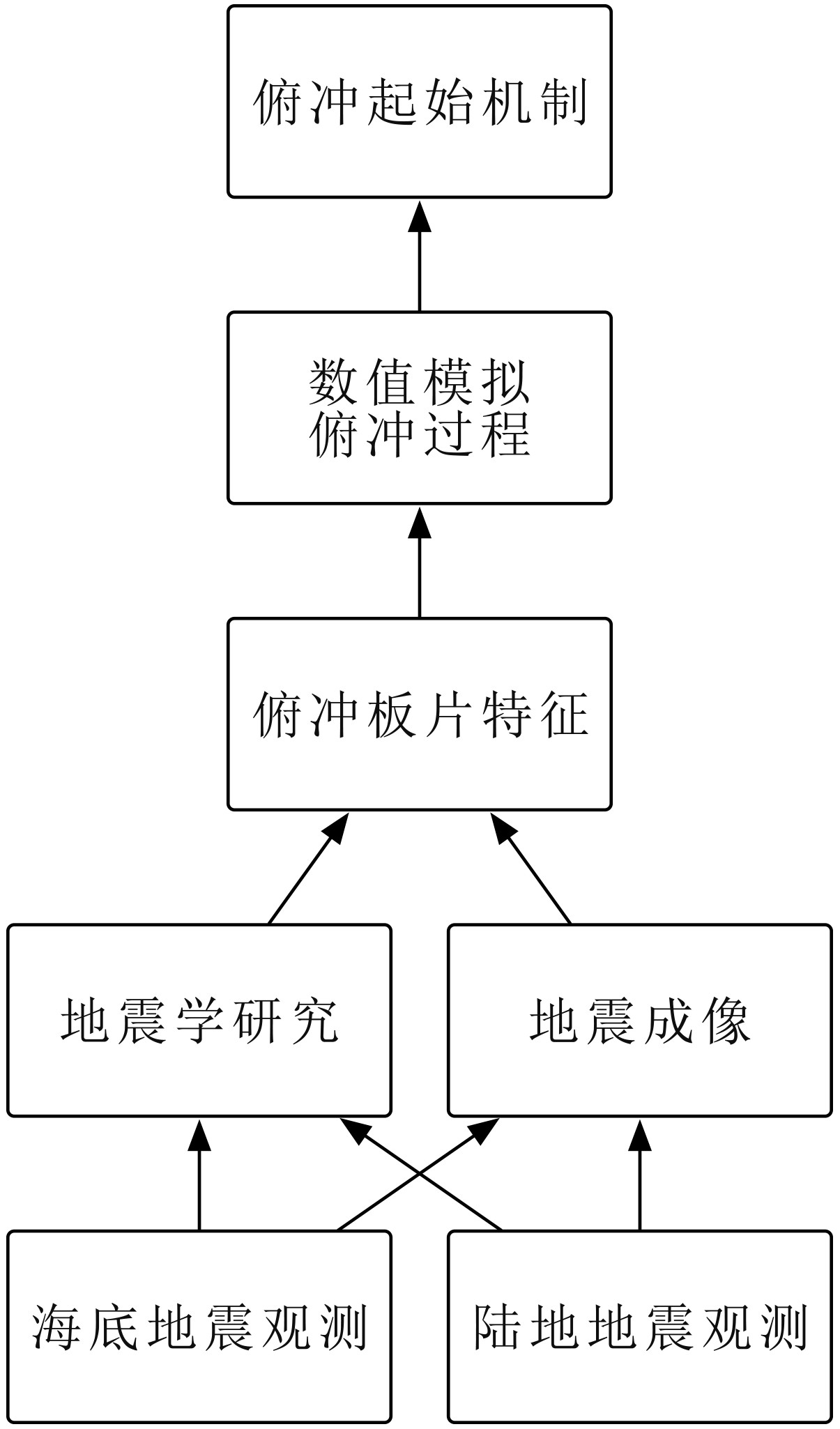Introduction to the 3-D seismic observation of the north Sulawesi subduction zone and the study of initiation mechanism
-
摘要:
苏拉威西海具有独特的演化过程—位于北婆罗洲及苏禄岛弧下的苏拉威西海板块停止俯冲后,其俯冲板块的另一侧开始向苏拉威西岛俯冲,形成了诸如俯冲转换边缘、对向俯冲系统等独特的地质现象。针对这种同一板块一侧俯冲停止后在板块另一侧发育新俯冲的过程,科学界提出了众多的板块初始俯冲机制模式,如前陆盆地碰撞后发育新俯冲、大陆/岛弧边缘重力失稳后解耦后俯冲、岩石圈浅部小范围的地幔对流活动导致俯冲等14种初始模式。由于难以获得处于俯冲初始阶段俯冲带的深部岩石圈的地震观测资料,造成这些板块活动模式仍止步于推测。苏拉威西海区的天然地震观测资料不仅是研究苏拉威西海俯冲系统岩石圈深部构造及演化的基础,而且也是认识俯冲过程初始机制的关键一环。本文重点介绍了国家自然科学基金委员会重大研究计划“西太平洋地球系统多圈层相互作用”所属重点项目“苏拉威西海与古南海对向俯冲系统的三维地震观测与板块活动机制”在苏拉威西海区针对北苏拉威西海俯冲板片结构所开展的三维地震观测研究。该项研究实验以揭示俯冲系统深部结构与板块活动机制为目标,通过多边国际合作,于2019年8月15—25日在苏拉威西海区成功投放了27台国产宽频带海底地震仪(BBOBS),拟采集10个月的天然地震数据。同时计划利用印尼合作方的陆区地震台站数据,与OBS数据一同开展研究区岩石圈三维结构的地震学研究与数值模拟,认识俯冲下插板片的变形形态与特征、上覆地壳增厚程度及与俯冲系统持续作用过程之间的关系,讨论该地区独特俯冲系统的初始机制。
Abstract:The Celebes sea has a unique evolutionary history. When the oceanic crust of Celebes below the north Borneo and Sulu arcs stopped subducting, the plate on the other side began to subduct towards the northern arm of the Sulawesi Island. Several unique geological structures, such as the subduction transform edge propagator, double inward subduction were formed. This dynamic tectonic process, from subduction cessation to initiation in a relatively short period of time is a distinctive feature of the western Pacific subduction system. To explain its physical mechanisms of the process, many models to explain the subduction initiation mechanism have been proposed, such as the post-collision development from foreland arcs, gravity instability initialization at the arc/continental margins and sub-lithospheric mantle convection etc.. Due to deficiency of high resolution seismological data of the incipient subduction zone structure, these mantle dynamic models are still remaining in debate. Acquiring earthquake observation data from the incipient subduction system is not only the basis for studying the deep structure and evolution of its lithosphere, but also a key element in understanding the initial mechanism of the subduction process. This paper introduces the 3-D offshore earthquake observation experiment focusing on the structure of the incipient subduction zone of the North Sulawesi, which is supported by the National Science Foundation of China key project “3-D seismic observation and plate movement mechanism of the inward subduction system in Celebes Sea and proto-South China Sea”. The objective of this experiment is to reveal the deep structure of the incipient subduction system and the mechanism of plate movement, 27 broadband ocean bottom seismometers (OBS) were deployed from August 15 to 25, 2019 through international collaboration to record seismic data for 10 months. It plans to study the 3-D structure of the lithosphere of the north Sulaweis subduction zone and carries out numerical simulation analysis of its plate movement. Using the OBS and the land seismic stations data together, we can study the deformation pattern and characteristics of subducting plates, overlying crust and its relationship with the continuous shorting of double subduction, to reveal the mechanism of this incipient subduction system.
-

-
图 2 近20 Ma以来印尼东部海域及澳大利亚北部陆缘地区海沟后撤示意图[11]
Figure 2.
-
[1] Mckenzie D P. The initiation of trenches: a finite amplitude instability[M]//Talwani M, Pitman W C. Island Arcs, Deep Sea Trenches, and Back-Arc Basins. Washington, D. C.: AGU, 1977, 105: 57-61.
[2] Gerya T. Introduction to Numerical Geodynamic Modelling[M]. 2nd ed. Cambridge: Cambridge University Press, 2019: 369-405.
[3] Stern R J. Subduction zones [J]. Review of Geophysics, 2002, 40(4): 1012. doi: 10.1029/2001RG000108
[4] Stern R J. Subduction initiation: spontaneous and induced [J]. Earth and Planetary Science Letters, 2004, 226(3-4): 275-292. doi: 10.1016/S0012-821X(04)00498-4
[5] Stern R J, Gerya T. Subduction initiation in nature and models: a review [J]. Tectonophysics, 2018, 746: 173-198. doi: 10.1016/j.tecto.2017.10.014
[6] Lévy F, Jaupart C. The initiation of subduction by crustal extension at a continental margin [J]. Geophysical Journal International, 2012, 188(3): 779-797. doi: 10.1111/j.1365-246X.2011.05303.x
[7] Uyeda S, Ben-Avraham Z. Origin and development of the Philippine Sea [J]. Nature Physical Science, 1972, 240(104): 176-178. doi: 10.1038/physci240176a0
[8] Casey J F, Dewey J F. Initiation of subduction zones along transform and accreting plate boundaries, triple-junction evolution, and forearc spreading centres–implications for ophiolitic geology and obduction[M]//Gass I G, Lippard S J, Shelton A W. Ophiolites and Ocean Lithosphere. Geological Society, London, Special Publications, 1984, 13(1): 269-290.
[9] Coleman R G. Tectonic setting for ophiolite obduction in Oman [J]. Journal of Geophysical Research: Solid Earth, 1981, 86(B4): 2497-2508. doi: 10.1029/JB086iB04p02497
[10] Boudier F, Ceuleneer G, Nicolas A. Shear zones, thrusts and related magmatism in the Oman ophiolite: initiation of thrusting on an oceanic ridge [J]. Tectonophysics, 1988, 151(1-4): 275-296. doi: 10.1016/0040-1951(88)90249-1
[11] Hall R. The subduction initiation stage of the wilson cycle [J]. Geological Society, London, Special Publications, 2018, 470(1): 415-437.
[12] Govers R, Wortel M J R. Lithosphere tearing at STEP faults: response to edges of subduction zones [J]. Earth and Planetary Science Letters, 2005, 236(1-2): 505-523. doi: 10.1016/j.jpgl.2005.03.022
[13] Kopp C, Flueh E R, Neben S. Rupture and accretion of the celebes sea crustrelated to the North–Sulawesi subduction: combined interpretation of reflection and refraction seismic measurements [J]. Journal of Geodynamics, 1999, 27(3): 309-325. doi: 10.1016/S0264-3707(98)00004-0
[14] Karig D E. Origin and development of marginal basins in the western Pacific [J]. Journal of Geophysical Research, 1971, 76(11): 2542-2561. doi: 10.1029/JB076i011p02542
[15] Weissel J K. Evidence for Eocene oceanic crust in the Celebes basin[M]//Hayes D E. The Tectonic and Geologic Evolution of Southeast Asian Seas and Islands. Washington, D. C.: AGU, 1980: 37-47.
[16] Silver E A. A new tectonic map of the Molucca Sea and East Sulawesi, Indonesia, with implications for hydrocarbon potential and metallogenesis[M]//Barber A J, Wiryosujono S. The Geology and Tectonics of Eastern Indonesia. Bandung: Geological Research and Development Centre, Special Publications, 1981, 2: 343-347.
[17] Silver E A, McCaffrey R, Smith R B. Collision, Rotation, and the Initiation of Subduction in the Evolution of Sulawesi, Indonesia [J]. Journal of Geophysical Research: Solid Earth, 1983, 88(B11): 9407-9418. doi: 10.1029/JB088iB11p09407
[18] Hinz K, Fritsch J. Geoscientific Investigations in the Celebes Sea and on the adjacent Subduction Zones (GIGICS)-SO98, Report on the SONNE cruise SO98/2, Geophysical Survey inthe Indonesian Part of the Celebes Sea, 1 November 1994-28 November 1994[R]. Unpubl. report BGRno. 113.095, 1995.
[19] Rangin C, Silver E A, Von Breymann M T, et al. Summary of shipboard results[C]//Proceedings of the Ocean Drilling Program, Initial Repo. College Station, TX, 1990, 124: 415-419.
[20] Rangin C, Silver E A, Von Breymann M T, et al. General introduction[C]//Proceedings of the Ocean Drilling Program, Initial Repo. College Station, TX, 1990.
[21] Hall R. Late Jurassic–Cenozoic Reconstructions of the Indonesian Region and the Indian Ocean [J]. Tectonophysics, 2012, 570-571: 1-41. doi: 10.1016/j.tecto.2012.04.021
[22] Otofuji Y I, Sasajima S, Nishimura S, et al. Paleomagnetic evidence for clockwise rotation of the northern arm of Sulawesi, Indonesia [J]. Earth and Planetary Science Letters, 1981, 54(2): 272-280. doi: 10.1016/0012-821X(81)90010-8
[23] Surmont J, Laj C, Kissel C, et al. New paleomagnetic constraints on the Cenozoic tectonic evolution of the North Arm of Sulawesi, Indonesia [J]. Earth and Planetary Science Letters, 1994, 121(3-4): 629-638. doi: 10.1016/0012-821X(94)90096-5
-




 下载:
下载:


